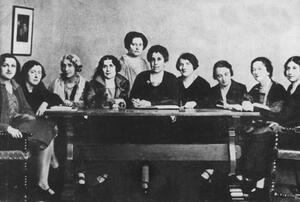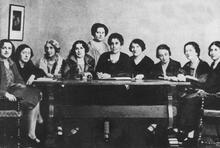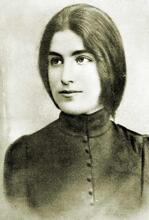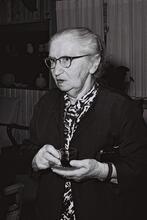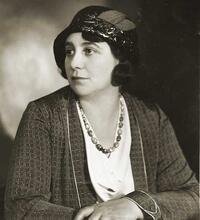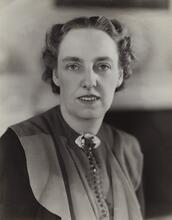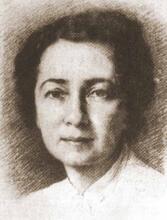WIZO: Women's International Zionist Organization (1920-1970)
Founded in London by members of the Ladies’ Committee of the Zionist Federation of Britain, the Women’s International Zionist Organization (WIZO) offered an opportunity for women who felt marginalized by existing Zionist organizations. Moreover, the founders believed that in order for the establishment of a Jewish state to succeed, the Zionist movement must support and uplift women and children. The two main offices were in London and Tel Aviv, with satellites around the world, though most of the organization’s energies went toward supporting Jewish women in Palestine. WIZO frequently collaborated with and provided funds for initiatives begun by existing and nascent local organizations supporting newly arrived women and children through the provision of healthcare and childcare, agricultural education and professional training, and employment opportunities.
Historical Background
Three factors combined to contribute to the establishment of the Women’s International Zionist Organization (WIZO): the political and social awakening of European women in general and British women in particular; the Zionist movement’s increased momentum upon the publication of the Balfour Declaration and the transfer of its center of activity to Britain after World War I; and the personal biographies of WIZO’s founders.
The Ladies’ Committee of the Zionist Federation of Britain preceded WIZO. Dissatisfied with the limited role they were permitted to play in Zionist activity, the committee members, who included three founders of WIZO—Rebecca Sieff, Vera Weizmann, and Romana Goodman—decided to establish a separate Zionist women’s organization in Britain. A general assembly to found the women’s federation was held on January 12, 1919, with the agreement of the British Zionist Federation. Twelve organizations of Zionist women also joined, as well as several individuals such as Henrietta Irwell and Lady Beatrice Samuel (née Franklin, 1871–1959). Most of the women who joined either had experience in public activity, whether in local Zionist women’s organizations or in the general Jewish community, or had a general interest in political movements.
Most of the women were wives of men who held senior positions in the Zionist Federation. For example, Rebecca Sieff was the wife of Israel Sieff (1889–1972); Edith Eder was the wife of Dr. Montague David Eder (1865–1936), and Vera Weizmann was married to Dr. Chaim Weizmann. In 1918 they accompanied their husbands, members of the Zionist Commission for Palestine, on a tour of Palestine, where they held discussions with a great number of women engaged in pioneering work. Alerted to the significant problems faced by women and children there, they returned to London with far-sighted reports on the needs of the population and plans for improving prevailing conditions by establishing social and welfare services and institutions for the agricultural and vocational training of young women.
On July 11, 1920, at the first Zionist conference held after World War I, Olga Ginsburg initiated the founding of the Women’s International Zionist Organization, together with representatives from organizations in Palestine, England, Germany, Poland, the Netherlands, Russia, and South Africa. It was decided to establish an office in Palestine, which would be a branch of the world center in London, and to divide the work between the two. In time, numerous other WIZO branches were set up in Jewish communities worldwide. Their main purpose was fundraising, whether by charging membership dues or by soliciting contributions to defined goals in Palestine.
Between 1921 and 1933, WIZO focused on its work in Palestine and on developing the movement in the Lit. (Greek) "dispersion." The Jewish community, and its areas of residence, outside Erez Israel.Diaspora, excluding the United States and Canada. The years 1933 through World War II witnessed the annihilation of Jewish communities in Europe and the dissolution of WIZO Federations in countries under the Nazi scourge. This was also the era when nineteen new Latin American WIZO Federations were created. The immediate postwar period was that of the resuscitation of WIZO Federations and groups in Europe.
In 1949, following the establishment of the State of Israel, the WIZO Head Office was transferred from London to Israel. Rebecca Sieff was elected the first president of the World WIZO Movement, serving in that position until 1963. She was followed by Rosa Ginossar, who was elected chairwoman of the World WIZO executive in 1951, acting president in 1963, and president in 1966. In 1970 Raya Jaglom was elected president and held office until 1996. During her term of office, WIZO was established in the United States in 1981 as well as in Hong Kong, Budapest, and Prague. At the same time, WIZO was recognized as a non-governmental organization with consultative status to ECOSOC and UNICEF.
In 1996 Michal Modai, former chairwoman of the executive of the Israel Federation and of the World WIZO Executive, was elected President of World WIZO. Helena Glaser, chairwoman of the WIZO Israel Federation, was elected chairwoman of the World WIZO Executive.
WIZO in Palestine

Courtesy of Ha-Keren le-Ezrat ha-Isha.
WIZO activity in Palestine began on an individual and unorganized basis when a number of women, who had assisted two British nurses sent to Tel Aviv by WIZO to guide mothers, decided to extend further help. Only in 1927 did the women officially organize into a group called the National Federation, which rapidly attracted more than 700 members and became the official WIZO branch in Palestine. In 1931 Hadassah Samuel (1897–1986) was elected the first chairwoman.
As activity increased, four committees were set up to divide the various areas of responsibility: home economics, kindergartens, home industry, and evening classes for girls aged thirteen to sixteen who were already at work. WIZO also offered financial support to the poorly funded Union of Hebrew Women for Equal Rights in Erez Israel, which campaigned for women’s suffrage and equal rights. The organizations merged in 1948.
Goals
The goals and work plans presented by the WIZO founding committee focused on the realization of the Zionist idea; the primary motivation for uniting in a women’s Zionist organization was that the existing organizational settings provided no opportunity for them to be active. Moreover, they proclaimed that in order to realize the dream of building a national homeland, one must promote the welfare of women and children. Through education and training, women must develop their unique gifts in order to maximize their potential contribution. The fields of activity were education, home economics, and social services, which were neglected in Palestine at that time. Under the influence of Hannah Maisel-Shohat, WIZO emphasized agriculture as a first step toward national revival, demanding the establishment of an agricultural school for women so that farmers’ wives could be trained in “the agricultural aspects of village life.” Although WIZO’s constitution was later revised and amended, its basic goals remained the same over time.
A detailed work plan presented at WIZO’s first assembly, held at the Twelfth Zionist Congress in Karlsbad in 1921, proposed practical activity in Palestine: founding a hostel and agricultural school for young immigrant women, providing kitchen equipment for the girls’ school in Haifa, and establishing a day care center for babies.
Early Activities
The beginning of WIZO coincided with the early years of another group of Jewish women in Palestine concerned with the plight of mothers and children. The Histradrut Nashim Ivriot (Hebrew Women’s Organization) started the first well-baby clinics, which provided guidance and information to pregnant women and women who had delivered their babies at home. This led to the establishment of counseling centers which also provided milk to women who had recently given birth. A budget shortfall caused the transfer of the Jerusalem and Tel Aviv centers to Hadassah Hospital. When the latter was established, Tel Aviv WIZO supported it. When the Zionist Federation adopted the concept of well-baby clinics, London WIZO sent two specially trained nurses to Tel Aviv to work in WIZO’s first clinic for pregnant women. The center, which aimed to serve women of the old Jewish community in Palestine prior to the establishment of the State of Israel. "Old Yishuv" refers to the Jewish community prior to 1882; "New Yishuv" to that following 1882.Yishuv in Jaffa as well as recent immigrants of the new Yishuv, became a model for the well-baby clinics established by various sick funds and later operated by Israel’s Ministry of Health.
The Hebrew Women’s Organization pioneered social work in the Yishuv, helping those in need by means of a sewing committee, clothing distribution, and care of orphans. The novel aspect of their philosophy lay in maintaining that needy people are receiving not charity but their rightful allocation as members of society, and thus helping them was not philanthropy but community-building. Work began in Jerusalem with the help of the Hadassah Organization.
A home for infant orphans was founded in Jerusalem in 1925 by Helena Kagan, a physician who also served as its director on a voluntary basis. The institution was the only one of its kind until the WIZO Mother and Child Center opened in Tel Aviv in 1929. In the same year, WIZO took responsibility for the infants’ home in Jerusalem, relocating and expanding the center several times before opening the Rebecca Sieff Center for the Family in 1955 in the Beit Hakerem neighborhood of Jerusalem.
The Hebrew Women’s Organization hoped that the field of social work would be transferred to the public authorities. By organization into political parties and participation in the elections for the Asefat ha-Nivharim (Elected Assembly), the Hebrew Women’s Organization succeeded in transferring responsibility to the Va’ad Le’ummi (National Council), to which Henrietta Szold was elected for the purpose of establishing the social welfare department. However, social work—especially in the area of mothers and babies—continued to be a major activity of Zionist women; volunteers worked alongside professional personnel in the social welfare offices which were set up in various cities.
WIZO applied the broadest possible definition of social work: extending help of various kinds to all people in need. As the waves of immigration increased, the Zionist women geared themselves for immigrant absorption, which included maintaining immigrant hostels, inexpensive restaurants, guidance bureaus, and classes in Hebrew, cooking and sewing. After the state was founded, cooperation continued between government welfare agencies and volunteer organizations, including WIZO (which absorbed the Hebrew Women’s Organization in 1933).
Education in Agriculture
WIZO regarded the training of women in agriculture as part of the Zionist enterprise. Since Jews in general and women in particular had not engaged in agriculture in their countries of origin, they required proper training. This was carried out via three parallel channels: agricultural schools, educational farms, and traveling counselors.
At the time of WIZO’s founding, the only agricultural school already in existence, Mikve Israel, did not accept girls. The first agricultural training for young women officially opened in Tel Aviv in 1922, directed by Hannah Maisel-Shohat. In 1936 it was moved to a boarding school in Nahalat Yizhak. The women were trained in areas deemed important for managing a household, such as cooking, growing vegetables, and raising chickens. In 1925, WIZO took upon itself the establishment and upkeep of the agricultural school in Nahalal, also directed by Hannah Maisel-Shohat, intended for 60 young women aged eighteen to 25 studying over a two-year period. Studies were both theoretical and practical. Applicants from abroad were given preference, since some of them received immigration certificates as a result of having been accepted for study. During World War II studies were opened to young local women because of lower immigration rates. In 1946, for the first time, a mixed-gender class from among the “Tehran children” (Youth Lit. "ascent." A "calling up" to the Torah during its reading in the synagogue.Aliyah children from Poland who were brought to Palestine via Tehran) was accepted to help absorb refugee children. Other WIZO agricultural schools, which were established after Nahalal’s success, took in refugee children and have remained co-educational.
During the 1920s, the Mo’ezet ha-Po’alot (Council of Women Workers), in cooperation with the Jewish Agency and the Jewish National Fund, set up six training farms for women. These Women Workers’ Farms provided two years of practical training in all fields of agriculture. Since they lacked funding, WIZO was asked to help. It sponsored four of the six farms (in Afulah, Shekhunat Borochov [now Givatayim], Nahalat Yehudah [an urban community near Rishon le-Zion] and Petah Tikvah), managing them in cooperation with the Mo’ezet ha-Po’alot. A different type of educational farm, the Hadassim Youth Village was founded in 1947 expressly to serve immigrant youth, becoming an independent high school in 1952. For many years Youth Aliyah sent groups of young people to agricultural institutions, where they received professional training and were in the company of native-born youngsters.
The Training Department was set up in 1927 to extend agricultural education to private homes, and later also to kindergartens and schools. During the economic crisis and the fourth wave of aliyah, the food shortage led people to grow their own vegetables. WIZO provided professional guidance through traveling counselors, distributing seeds, fertilizer, and sometimes even loans. In 1931, the Va’ad Le’ummi appointed WIZO’s counseling department to supervise all gardens near kindergartens and schools. The counseling department also provided counselors for A voluntary collective community, mainly agricultural, in which there is no private wealth and which is responsible for all the needs of its members and their families.kibbutzim, and later to Lit. "village." The dominant pioneer settlement type of the Jews in Palestine between 1882moshavim, to help with growing vegetables. When Israel was founded, the counselors were absorbed into agricultural education in the Ministry of Agriculture’s Counseling Department. Guidance activity on immigrant settlements continues to this day and includes many types beyond agriculture.
Professional Training and Employment
Because of the emphasis on agriculture in The Land of IsraelErez Israel, there had been little to no focus on any other kind of vocational training. WIZO became a pioneer in this field, broadening the scope of professional training for women in Palestine, which had previously been restricted to nursing. A school for home economics was opened in 1922, followed by two schools for child-care givers, in Jerusalem and Tel Aviv respectively, and a vocational school in Haifa. WIZO training was also provided through short-term courses, which were intended for older women and those with families. Along with its training programs, WIZO established industries that provided women with income-earning opportunities both in their homes and outside. During the 1920s WIZO was unique in this field, which was later adopted by other organizations. Home industry was performed in people’s homes or factories specially set up for the purpose, and products were sold in two WIZO stores in Tel Aviv and Haifa. This widening of employment options helped women improve their economic situation and furthered the adaptation of immigrant women’s handicrafts to Israeli market trends.
Nutrition
WIZO also provided training in women’s traditional tasks, such as cooking and running a household. Activities connected with nutrition took two forms: various counseling centers provided training in areas such as parenting, cooking, nutrition, and even the management of public kitchens; other centers provided indigent people with basic provisions through milk distribution, kindergarten and school lunches, various institutions for abandoned children, and an affordable cafeteria.
Consumerism
WIZO’s contributions include inculcation of the concept of consumerism into Israeli society. The initiative for organizing consumer groups originated in WIZO’s belief that only a strong organization could achieve social objectives. During the Yishuv period, WIZO was part of the campaign for “Domestic Products” (Tozeret ha-Arez). It continued its work in this area by establishing a consumer organization as part of the Council of Women’s Organizations, which later became the Israeli Consumer Council, a government agency.
Summary
All WIZO’s activities have one thing in common: aid to immigrant women. The special needs of each wave of immigration and the economic situation of each period dictated the nature of WIZO’s activity.
WIZO was characterized by a pioneering spirit, aspiring to create a civil society (i.e. the transfer of responsibility for certain areas to government institutions) and effective organization in Erez Israel. In all these, it has been extremely successful. WIZO’s standing as a worldwide organization, combined with the focus of individual communities on specific projects, provided financial resources for its programs.
Grove-Pollak, Fay. The Saga of a Movement: WIZO 1920-1970. Tel Aviv: Department of Organization and Education of WIZO, 1970.
Herzog, Hanna and Ofrah Grinberg. A Voluntary Women’s Organization in a Society in the Making: WIZO’s Contribution to Israeli Society. Tel Aviv: Tel Aviv University, 1981.
Shvarts, Shifra and Zipora Shehory-Rubin. “On Behalf of Mothers and Children in Eretz Israel: The Activity of Hadassah, the Federation of Hebrew Women, and WIZO to Establish Maternal and Infant Welfare Centers—Tipat Halav, 1913-1948.” In Jewish Women in Pre-State Israel: Life History, Politics, and Culture, edited by Ruth Kark, Margalit Shilo, and Galit Hasan-Rokem, 180-192. Waltham: Brandeis University Press, 2008.

